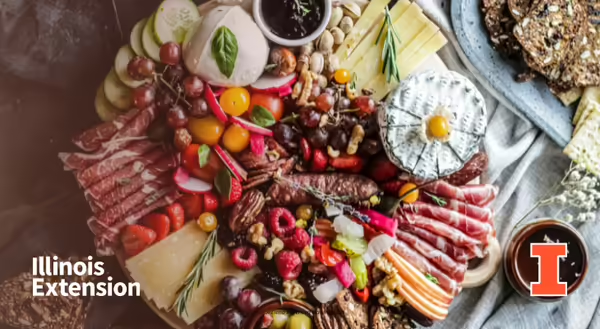
It’s all the rage right now. Charcuterie (pronounced shar-koo-tuh-ree) boards are the latest conversational piece at the holiday party. In the simplest terms, it’s a tray loaded with all sorts of finger foods, commonly eaten as an appetizer. Think cured meats, cheeses, crackers, nuts, veggies, fruits, pickled items, sauces, and spreads. The term “charcuterie” refers to the culinary art of preparing cured meats, meat that is ready to be eaten. As such, charcuterie boards most often contain meats like salami, prosciutto, summer sausage, ham, or cured chorizo. However, the best thing about charcuterie boards is you can use whatever foods you like!
Impress guests this holiday season with an easy charcuterie board
Most any board or platter can be used, as long as it’s food-safe and not some 2x4 in your garage. Wooden cutting boards, platters, serving trays, or even butcher paper on your kitchen counter will work. When thinking about what to put on your charcuterie board, consider a variety of colors, textures, and flavors. Add foods that are sweet, savory, salty, and spicy. There’s something soothing about arranging food into a beautiful artwork display!
The healthiest of charcuterie boards are those that contain piles of fresh fruits and veggies, which are a good source of vitamins, minerals, and dietary fiber. A charcuterie board can contain all five food groups in MyPlate (fruit, vegetable, grain, protein, and dairy). While processed meat is in the protein group, high intakes can increase the risk of cancer. Choose smaller amounts of meats and fill in the gaps with nuts and hummus. Choose whole grains, such as whole-grain crackers, and remember to not completely gorge yourself on the cheese.
Charcuterie board ingredient ideas
- Veggies: Cucumber slices, cherry tomatoes, mini peppers, sugar snap peas
- Fruits: Grapes, strawberries, raspberries, blackberries, dates, dried apricots
- Cheeses: Fresh mozzarella (soft), brie, cheddar (semi-hard), gouda, Havarti
- Meats: Salami, prosciutto, ham, summer sausage
- Nuts: Almonds, cashews, pistachios
- Breads: Whole wheat crackers, baguette slices, pretzels
- Pickled Elements: Olives, cornichons, pepperoncinis
- Spreads: Olive oil, jalapeno jelly, stone ground mustard, hummus
Instructions
Choose a large board or serving platter. Place all spreads in small serving dishes and arrange on the platter. Wash and slice all fruits and veggies. If needed, slice cheese, meat, and breads. Place ingredients that you want the most of on the board first. Then fill in the gaps with your other items. Serve immediately. Store all but nuts, breads, dried fruits, and oil in the refrigerator.
PHOTO CREDIT: Photo by Anto Meneghini on Unsplash
ABOUT THE AUTHOR: Jenna Smith is a Nutrition and Wellness Educator with University of Illinois Extension, serving Livingston, McLean, and Woodford Counties. Smith uses her experience as a registered dietitian nutritionist to deliver impactful information and cutting-edge programs to Livingston, McLean, and Woodford Counties and beyond.
This blog originally appeared in the Pantagraph on November 10, 2021.